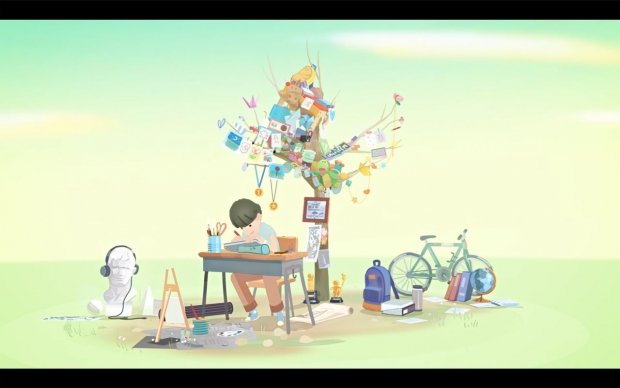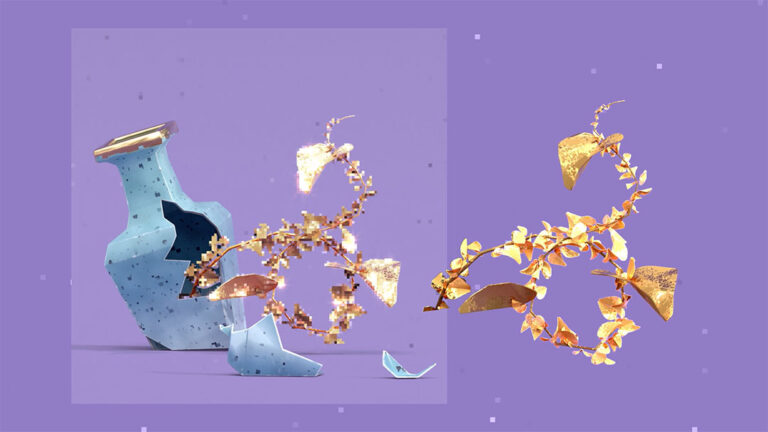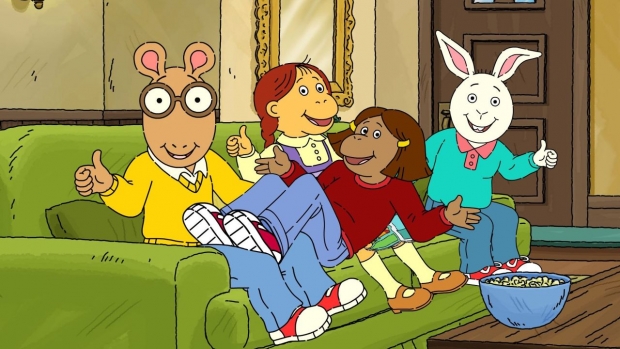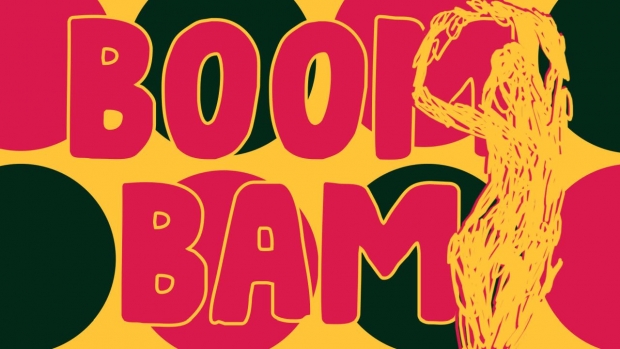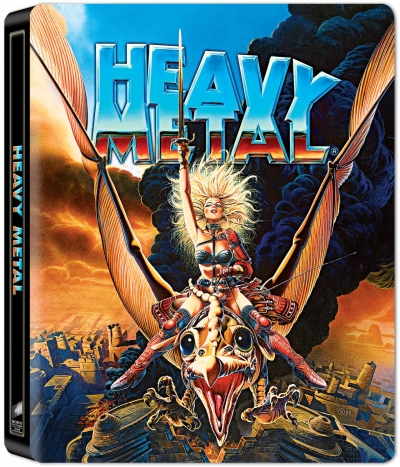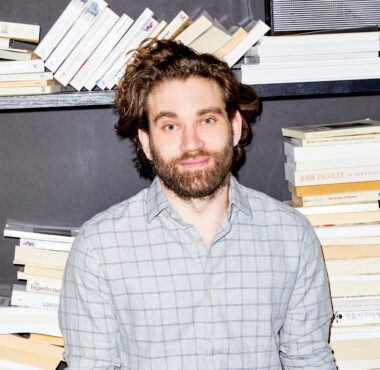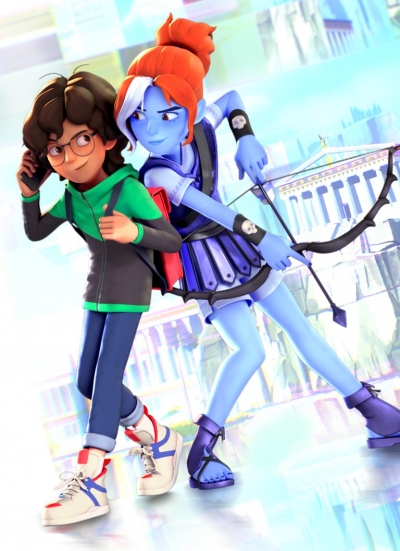The 12-minute film, named after the Korean word for “Tree,” illustrates the life of a young painter who, after experiencing romantic heartbreak, begins to forget his creative passions, growing up as a businessman who’s a slave to time. But, after years of pushing his art to the side, the man discovers that life, though fleeting, does come full circle in the end and that even passions one’s neglected for years can be brought to life again. Even in its darkest moments, the film’s honest reflection of life is enhanced by water-color animation touched with a child-like aesthetic and innocence.
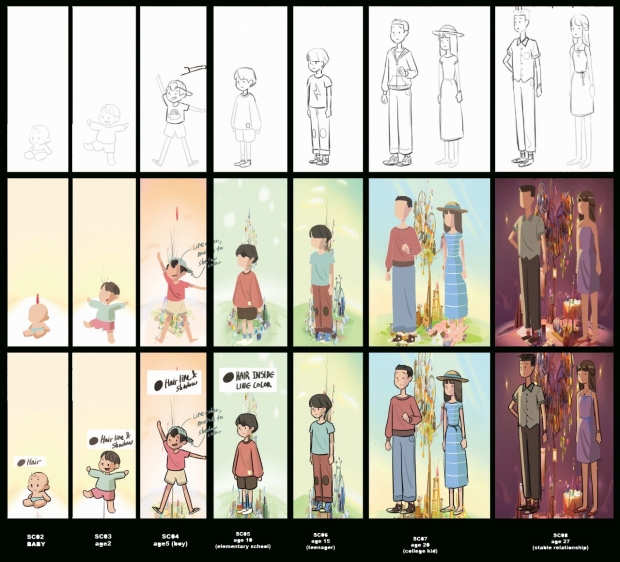
“It’s deeply personal, but I feel like it’s universal enough for everyone to resonate with,” explains Oh, known for his innovative animated short Opera that was nominated for Best Animated Short at last year’s Academy Awards. “It’s not a story about my grandfather. It’s all about growth and change.”
He adds, “It’s also more fun as an artist to work in this sort of space where you can hand paint the objects, and you can grab them and move them. It feels kind of like playing with toys, almost kind of like building LEGO sets at times.”
Since Quill doesn’t have frame interpolation or CG lighting tools, the team couldn’t reuse models of characters or settings. Every frame, every character and every object had to be hand-painted over and over again each time the camera angle or lighting changed, with texture effects also being added only by the paintings of the Quill artists.
Fan notes, “We had to hand-paint every single object a bajillion times. And if Erick decided he wanted to shoot from a new angle, we had to repaint. So it was definitely difficult. But I think it looks gorgeous and we couldn’t be happier with it. We’re so proud every single time we watch it.”
Oh also hopes that audiences not only see themselves in the story, but that Namoo gives them pause to reflect and re-evaluate their own life and the things, and people, most important to them. “I want them to think about their life, or their father or grandfather or someone who they love,” he concludes. “And then hopefully, think about their own tree of life.”
Even though Namoo is a 3D animated film, Ladd says the process of painting and animating the story in Quill was much more akin to the process of stop-motion or traditional 2D animation.
With virtual reality headsets, two Quill artists – assisted by a third artist for character animation – were able to enter Namoo’s settings, fully immersed in the world as they painted the environments and brought these characters to life, transforming Oh’s initial 15 concept drawings into a film.
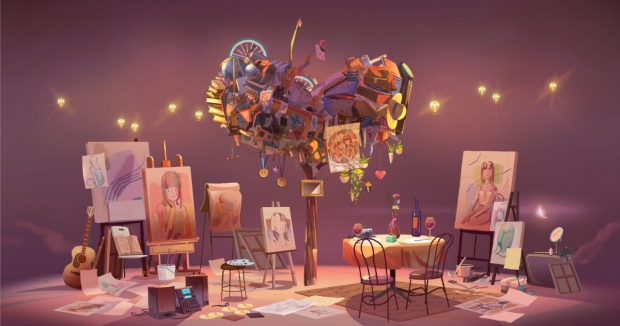



Ladd also says being fully immersed in the Namoo world – be it a dark and windy storm or a calm, candle-lit evening of love – added to the emotional connection he already had with the film.
“You hand-paint your character, you hand-paint your set, and then, frame by frame, you animate the characters posing,” he explains. “So, you pose them, add some keyframes, next frame, pose it again, and pose it again. It’s a lot like stop-motion. But, because it’s virtual, you get the benefit of going back if you make a mistake.”
One of those artists was lead Quill artist Nick Ladd.
This coming Monday, December 6, from 12:00 PM – 1:30 PM PST, Gnomon will be hosting a “Behind the Creative Process” talk where Namoo’s creative team will discuss how they turned a narrative poem into an animated virtual reality experience using Oculus’s VR animation. Oh, Lee, Ladd, and editor Vanessa Rojas will be presenting. You can find more information here; free registration can be found here.
It started, Erick Oh says, as a “therapeutic grieving process” following the death of his grandfather. But production of the Oscar-nominated director’s latest 3D animated short film Namoo soon became a process of self-realization for everyone on the project.
Namoo’s second starring character, an ever-growing and changing tree, remains a constant illustration of the man’s life throughout the film’s changing seasons. As the man grows from an infant to an adult, the tree accumulates in its branches a variety of toys, paintings, and memorabilia that reflect the main character’s life.
These vignettes and little memories tucked inside the tree are drawn directly from Oh’s childhood, such as a dinosaur plush toy he had as a kid. “My sister saw it and was like, ‘Oh my gosh, that’s the T-Rex plush you used to have,’” says Oh. “All my films I’ve done so far come from a very personal space, but this one’s extra special being inspired during the grieving process of losing my grandfather. It happened almost 10 years ago, so everything’s fine now, of course, but it was my first time saying goodbye to someone really close [to me].”
Lee adds, “What I really love about this film is there’s a certain openness to the way the stories are told. I just hope that people will look at it and think about themselves, their life and look at things from one step further back. Because, to me, it gives a comforting perspective on things.”
But though Namoo reflects so much on Oh’s own life, he believes that the film’s openness in the way the story is told is one of the reasons so many members of the production team see themselves in various sequences.
“This is the first time that anything this ambitious had ever been done in Quill before,” says Fan, who worked with Oh before on his film The Dam Keeper. “We want our studio to be a place where people with amazing visions come and we help them realize those visions. The reason why we did Quill is because this is about the ups and downs of life. Erick wanted that imperfection to be painted in there. And we felt it was important that it was literally hand painted, because our main character is a human painter, and it shouldn’t look perfect.”
He continues, “But then even moving on in the story, depicting the life of this character as an older guy who forgot about passion for a bit, that’s something I am scared of as an artist too. Working on this story not only gave me something that I can be passionate about and work on and focus on, but the story impacted me to step back a little from my life and look at it from a certain perspective. It gave me a certain perspective that we all just move forward. That there are ups and downs, but it’s going to be okay.”
The short was produced by nine-time Emmy Award-winning Baobab Studios, known for their VR animations such as Invasion! and Asteroids!, A highly emotional story, Namoo brought the studio’s team to tears at the first pitch session. “Both Eric Darnell and I were already huge fans of Erick,” says Baobab Studios’ CEO & co-founder Maureen Fan, who co-produced the film with Darnell, Baobab’s chief creative officer. “But after Erick pitched Namoo, so many on our team were crying, including me, that of course, it was a definite yes.”
“When I was approached for Namoo, I saw it as a great opportunity to reach new heights with this medium and pioneer some new techniques and just tell a really beautiful story in a brand-new way,” says Ladd, who worked closely with fellow lead Quill artist Dan Franke. “This is, by far, the most detail-oriented project I’ve worked on. It’s really tedious, but really rewarding.”
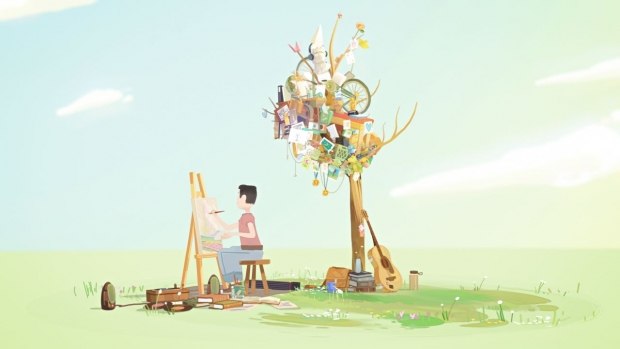
He continues, “You really just think about a lot of your life — where you come from, where we go after this. Those ideas and questions, nicely put together, became this piece.”
Victoria Davis is a full-time, freelance journalist and part-time Otaku with an affinity for all things anime. She’s reported on numerous stories from activist news to entertainment. Find more about her work at victoriadavisdepiction.com.
Eusong Lee, Namoo’s art director says that Oh has a way with “poetic illustrations” that really touch people, especially artists like himself. “There were a lot of moments that hit me hard,” he shares, “like the love sequence and the progression of when these two characters first meet, and then they are having dinner, and then they’re painting, and then there’s a quick cut and the girl’s gone. That progression was something that I could definitely relate to as a 30-year-old guy.”
“I was in those environments, in the film, being in this beautiful story, actually standing with those characters,” he says. “And you can really feel the emotion when you’re in those scenes because you’re surrounded by it. You kind of have to channel some of that emotion when you work because it inspires you.”
Both Oh and Baobab Studios are known for their innovative approaches to animated storytelling. Oh’s installation project, Opera, won the top prize for content across all artforms, awarded by the Korean government, in 2020; Baobab won the first-ever Best VR Annie Award, and SIGGRAPH’s Best in Show Award. But with Namoo, Baobab and Oh are attempting something new: hand-painting and animating a film using the VR illustration and animation tool Quill.
“We wanted to leave certain things less specific so that any person could put themselves into that experience,” explains Fan. “And so it becomes more universal in a way. I thought that was an elegant way to do it. We don’t want this to just be about this one man’s story. And what I love when I see this project is, at the end, it’s like, no matter how awesome you did, or how bad you did, it’s still a beautiful life.”
Oh adds that his approach to the art in the film, and his career, was also inspired by his grandfather. “My grandfather was not a painter, he was an educator, but he dedicated his whole life to make our world better,” the director says. “That spirit is definitely my guiding star as an artist. And this film’s character being a painter is definitely a reflection of my own life.”
She adds, “I’m an anxious person in general. And I think that’s why I have this need to achieve and look at myself based on what other people think. But it’s a good reminder, every time I watch Namoo, to remember not to get so in the weeds of the everyday and what’s going bad or good at the moment. At the end of the day, I need to stop and treasure my life the way it is, with all its bad and good.”

